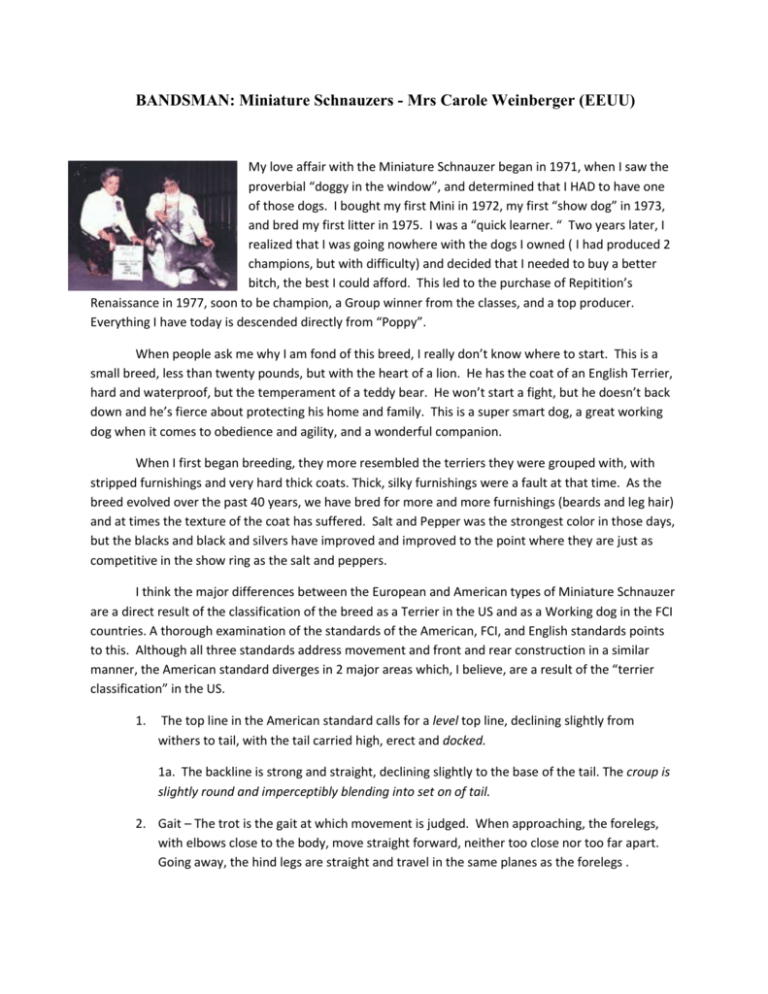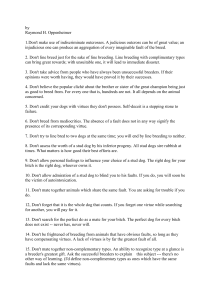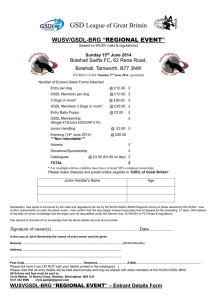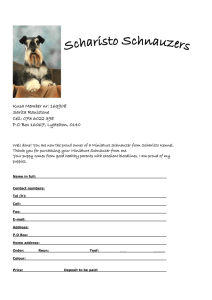BANDSMAN: Miniature Schnauzers
advertisement

BANDSMAN: Miniature Schnauzers - Mrs Carole Weinberger (EEUU) My love affair with the Miniature Schnauzer began in 1971, when I saw the proverbial “doggy in the window”, and determined that I HAD to have one of those dogs. I bought my first Mini in 1972, my first “show dog” in 1973, and bred my first litter in 1975. I was a “quick learner. “ Two years later, I realized that I was going nowhere with the dogs I owned ( I had produced 2 champions, but with difficulty) and decided that I needed to buy a better bitch, the best I could afford. This led to the purchase of Repitition’s Renaissance in 1977, soon to be champion, a Group winner from the classes, and a top producer. Everything I have today is descended directly from “Poppy”. When people ask me why I am fond of this breed, I really don’t know where to start. This is a small breed, less than twenty pounds, but with the heart of a lion. He has the coat of an English Terrier, hard and waterproof, but the temperament of a teddy bear. He won’t start a fight, but he doesn’t back down and he’s fierce about protecting his home and family. This is a super smart dog, a great working dog when it comes to obedience and agility, and a wonderful companion. When I first began breeding, they more resembled the terriers they were grouped with, with stripped furnishings and very hard thick coats. Thick, silky furnishings were a fault at that time. As the breed evolved over the past 40 years, we have bred for more and more furnishings (beards and leg hair) and at times the texture of the coat has suffered. Salt and Pepper was the strongest color in those days, but the blacks and black and silvers have improved and improved to the point where they are just as competitive in the show ring as the salt and peppers. I think the major differences between the European and American types of Miniature Schnauzer are a direct result of the classification of the breed as a Terrier in the US and as a Working dog in the FCI countries. A thorough examination of the standards of the American, FCI, and English standards points to this. Although all three standards address movement and front and rear construction in a similar manner, the American standard diverges in 2 major areas which, I believe, are a result of the “terrier classification” in the US. 1. The top line in the American standard calls for a level top line, declining slightly from withers to tail, with the tail carried high, erect and docked. 1a. The backline is strong and straight, declining slightly to the base of the tail. The croup is slightly round and imperceptibly blending into set on of tail. 2. Gait – The trot is the gait at which movement is judged. When approaching, the forelegs, with elbows close to the body, move straight forward, neither too close nor too far apart. Going away, the hind legs are straight and travel in the same planes as the forelegs . 2a. The FCI standard describes side movement. Flexible, elegant, agile, free and ground covering. The forelegs swinging as far forward as possible, the hind legs ground-covering and springy provide the necessary drive. The front leg of one side and hind leg of the other side move forward at the same time. The back, the ligaments, and joints are firm, There is no mention of front to rear movement except in the standard for the Standard Schnauzer which allows for single tracking, a fault in the movement of the American Miniature Schnauzer. 3. Tails- can we forget them. FCI now forbids docking and the American, don’t even try to show one with an undocked tail. It is a severe fault. The differences in the color of the Miniature Schnauzers are a very interesting topic. I have bred Champions in 2 colors and have had litters with puppies of all three approved (AMSC) colors. There are definite differences in the personalities of the colors. The black and silvers are more terrier like in temperament, a bit more aggressive with other dogs, noisier, and (at times) smarter. The salt and peppers strike a middle of the road position, calmer, quieter, un aggressive and easier to train. The blacks tend to be calm, calmer, and very easy going. They make the best family pets (with small children), are not aggressive with other dogs, and seem to value a nice nap above all else. Of course, these are just my observations and others who specialize in the various colors might disagree with me. The white Miniatures are fairly new to the breed, and while accepted in England and in the FCI, are still a forbidden color in the USA. Literature has shown that whites have occurred occasionally in litters over the years, even in America. However, I doubt that acceptance in the this country will be soon forthcoming, as we see the preponderance of White breeders here are the same breeders who breed particolors, livers, tans, blues and toys, and thus, many of their pedigrees are suspect to the AMSC. When I evaluate the Miniature Schnauzer, whether it is a ring situation, or for other reasons, the first requirement for me is squareness and balance. The standards for all three sizes refer to a squarely built dog, and this requires the proper blend of body length to leg length for balance. The dog must visually represent the breed it is purported to be. In other words, it HAS to LOOK like a Miniature Schnauzer before anything else. Our standard, the one I have bred to for 40 years, is quite specific when describing structure and movement. The description of the front assembly is taken from the standard of the Standard Schnauzer, and makes no allowances for straight shoulders, short upper arms, crooked legs, and restricted movement. There are allowances for slightly less fore chest in the American Standard, but NOT in the FCI standard and so it has to move like a working dog in profile. A dog that is made correctly will move correctly. This doesn’t call for excessive angulation, too much “snatch” (lifting of the hock) , or other extremes in movement. I worry that a concerted effort to get away from the restricted fronts of a few years ago has resulted in an incorrect application of the “reach and drive” principle, with some dogs showing too much angulation in the rear, longer loin areas to accommodate this angulation, and straight shoulders as well. I based my breeding program on a combination of dogs rather than one specific dog. The sire of my foundation bitch, Ch. Sky Rocket’s Upswing many be one of the most underrated dogs in the breed. He was bred very few times, comparably speaking, but was the sire or grandsire of some of the most prolific top producers in the breed. I had many good males and females from Poppy and her descendents, but it was the males that I had the most fun showing. A “Poppy” son, Ch. Bandsman’s Prophecy was the number 2 dog in the US, shown by Sue Baines in 1983. His older brother, Ch. Bandsman’s Legacy, owned b y MaryAnn Ellis and shown by Claudia Seaberg was a BIS and multi Group winning dog. It used to be difficult for me to turn my dogs over to a handler, since I made grooming my “specialty” and worked long and hard to become one of the breed’s best groomers. So of course, I figured I could do a better job than the handler. HA! No ego problem there, right?!! I would guess that Ch. Rampage’s Representative was probably one of the most influential sires of all times. I would compare him to Ch. Dorem Display in terms of his impact on changing the look of the breed. As a result of his influence, the American miniature became much more a terrier and less a working dog. This is possibly one of the biggest conflicts for new judges – which is more correct, the terrier or the working dog. As breeders, our job will be to combine the two looks into the Miniature Schnauzer called for in the Standard, a robust, active dog of terrier type, resembling his larger cousin, the Standard Schnauzer in general appearance. The question is” what is my biggest contribution to the breed?” That’s a hard one. Once I could say that I bred the top producing Black and Silver of all time. Ch. Bandsman Newsprint came along at a time when black and silvers were still in their infancy. He embodied all the structural points we want in a salt and pepper and he was black and silver as well!! He had a great show career and an even better stud career, as he was prepotent for those things that made him such a great dog! Unfortunately, he also carried the gene for a defect that allows the dog to be susceptible to the mycobacterium avium complex bacterial infection and it is always lethal. Fifteen years ago, we didn’t have the knowledge or the equipment to address, identify, and control the gene, and now we have a program going on at the U. of PA which may give us hope to eliminate the gene without eliminating the line. We can only hope. I would always recommend the breed to anyone who asked. We have relatively few medical problems and they make the best companions and pets ever. I know that I will always share my life with a Miniature Schnauzer. Bandsman Miniature Schnauzers began in 1974 and continues to this day. We count among our 100 champions, National Specialty winners, Best in Show and Multi Group winners, and local Specialty winners. Dogs from our Kennel have become the foundations for breeding programs both in the United States and around the World. The bitch, Am.Can.Ch. Bandsman’s Free Spirit is one of the top producing bitches of all time, having produced 11 champions from 16 puppies in 4 litters. She and her brother and sisters were one of 3 all champion litters that I have produced. My most recent litter is coowned and we are showing 4 out of 5 puppies, definitely the quality of litter that I enjoy!! Carole Luke Weinberger




